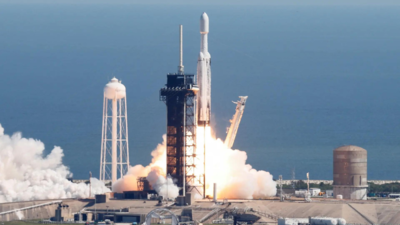
Nasa launches Europa Clipper from Kennedy Space Center, Florida (Picture credit: Reuters)
Nasa on Monday launched spacecraft
Europa Clipper
from Kennedy Space Center in Florida, US, to explore the possibility of life on
Jupiter
's moon Europa. The
spacecraft
took off on a
SpaceX Falcon Heavy
rocket under clear skies.
The $5.2 billion mission aims to explore whether Europa’s subsurface ocean, which lies beneath an ice shell over 10 miles thick, could be habitable.
It is Nasa's first mission dedicated to addressing this question.
Sandra Connelly, deputy associate administrator for Nasa’s science mission directorate, said, "Scientists believe
Europa
has conditions—water, energy, chemistry, and stability—beneath its icy surface that could support life."
"One of the Europa Clipper mission's main challenges is delivering a spacecraft hardy enough to withstand the pummeling of
radiation from Jupiter
but also sensitive enough to gather the measurements needed to investigate Europa's environment," Connelly added.
Nasa’s associate administrator, Jim Free, said that the mission will not search for actual living organisms. "What we discover on Europa will have profound implications for astrobiology and how we view our place in the universe," Free said.
Weighing around 12,500 pounds, the Europa Clipper spacecraft is equipped with nine instruments to study Europa’s ocean depth, surface compounds, and magnetic field. It is Nasa’s largest planetary mission, measuring approximately 100 feet long and 58 feet wide.
The spacecraft will use gravitational assists from flybys of Mars in February and Earth in December 2026. It is expected to enter Jupiter's orbit in April 2030 after traveling about 1.8 billion miles over 5-1/2 years and will conduct 49 flybys of Europa over a four-year period in a highly radioactive environment.
Nasa had planned to launch Europa Clipper last week but it was delayed due to Hurricane Milton.
Europa, the fourth-largest of Jupiter's 95 recognized moons, is believed to have twice as much water as Earth's oceans. It joins other celestial bodies like Callisto, Ganymede, and Enceladus that are thought to harbor hidden oceans.
The mission will assess whether Europa has the essential elements to support life—water, energy, and carbon-based molecules. Its radar can detect subsurface lakes and cryovolcanoes, while other instruments will study the moon’s atmosphere and possible water vapor plumes.
Planning for this mission began in 1995, said Tom McCord, a senior scientist on the mission. Despite doubts about Europa’s volcanic activity and energy sources, the mission could pave the way for future explorations of
ocean worlds
.

 1 month ago
20
1 month ago
20










 English (US) ·
English (US) ·